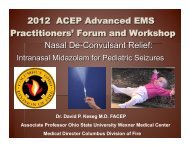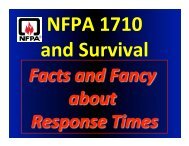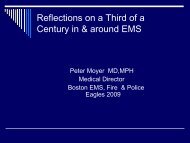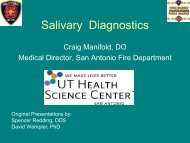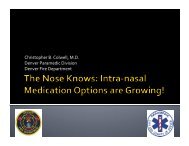Dr, William Fabbri - For The Life Of All Flesh Is The Blood Thereof
Dr, William Fabbri - For The Life Of All Flesh Is The Blood Thereof
Dr, William Fabbri - For The Life Of All Flesh Is The Blood Thereof
Create successful ePaper yourself
Turn your PDF publications into a flip-book with our unique Google optimized e-Paper software.
Pre-Hospital Hemorrhage Control<br />
In Special Civilian Populations:<br />
<strong>The</strong> Role of Tourniquets<br />
<strong>William</strong> <strong>Fabbri</strong>, M.D.,FACEP<br />
Medical <strong>Of</strong>ficer, FBI<br />
Medical Director, Emergency Medical Support<br />
And Operational Medicine<br />
Wednesday, February 25, 2009<br />
1
<strong>The</strong> opinions in this briefing are those of the author.<br />
<strong>The</strong>y do not necessarily represent the opinion of the Federal Bureau of Investigation<br />
or of the United States Government.<br />
Wednesday, February 25, 2009<br />
2
In military combat settings, deaths from<br />
uncontrolled hemorrhage account for<br />
approximately 50% of preventable deaths.<br />
Since the Korean War, 7-9% of these<br />
deaths were due to wounds controllable<br />
by compression (ex: extremity wounds)<br />
Wednesday, February 25, 2009<br />
3
Military “Care Under Fire”<br />
Phase1<br />
Wednesday, February 25, 2009<br />
4
Military “Care Under Fire”<br />
Phase1<br />
Return Fire and Take Cover<br />
Wednesday, February 25, 2009<br />
4
Military “Care Under Fire”<br />
Phase1<br />
Return Fire and Take Cover<br />
Move Casualty to Cover and apply self aid<br />
Wednesday, February 25, 2009<br />
4
Military “Care Under Fire”<br />
Phase1<br />
Return Fire and Take Cover<br />
Move Casualty to Cover and apply self aid<br />
Airway generally deferred until next<br />
phase* (*in civilian terms, “scene safe”)<br />
Wednesday, February 25, 2009<br />
4
Military “Care Under Fire”<br />
Phase1<br />
Return Fire and Take Cover<br />
Move Casualty to Cover and apply self aid<br />
Airway generally deferred until next<br />
phase* (*in civilian terms, “scene safe”)<br />
Stop life threatening external hemorrhage<br />
– By casualty self aid (self applied TQ)<br />
– Apply TCCC recommended TQ over clothing,<br />
2-3 in proximal to bleeding site<br />
1Tactical Combat Casualty Care Guidelines 2008<br />
Wednesday, February 25, 2009<br />
4
Recent Military Experience<br />
In the Iraq AOR:<br />
– Significant number of<br />
penetrating limb<br />
injuries (GSW/IED)<br />
– Self-Applied TQ<br />
– Rapid Access to EMS<br />
– Time to definitive<br />
surgical care 70 min or<br />
less.<br />
Photo courtesy NOMI<br />
Wednesday, February 25, 2009<br />
5
Similarities-Law Enforcement<br />
In the SWAT scenario:<br />
– Significant risk of<br />
penetrating limb injuries<br />
(GSW/IED)<br />
– Self-Applied TQ use<br />
– Rapid Access to EMS<br />
– Time to definitive surgical<br />
care 60 min or less.<br />
FBI photo<br />
Wednesday, February 25, 2009<br />
6
CSH Baghdad-2006<br />
Tourniquet Study2<br />
232 patients<br />
87% survival<br />
– When applied before shock developed: 90%<br />
– When applied after shock ensued: 10%<br />
Complications<br />
– Transient nerve palsy: 1.7%<br />
– Amputations caused by TQ: zero<br />
Wednesday, February 25, 2009<br />
7
CSH Baghdad-2006<br />
Tourniquet Study2<br />
In 5 patients with wounds deemed<br />
treatable by TQ who did not receive them:<br />
– “Lost pulse within minutes, died pre-hospital”<br />
– “Arrived w/o VS within 15 min of wounding”.<br />
Wednesday, February 25, 2009<br />
8
CSH Baghdad-2006<br />
Tourniquet Study2<br />
<strong>The</strong>se 5 fatalities who did not receive TQ<br />
were matched against 13 patients with<br />
similar Injury Severity Scales and<br />
Abbreviated Injury Scores:<br />
– Survival rate with TQ: 77%<br />
– Survival rate w/o TQ : zero<br />
2008;64:S38-50<br />
2 Kragh JF etal. J Trauma<br />
Wednesday, February 25, 2009<br />
9
CSH Baghdad 2006<br />
Tourniquet Study<br />
“Some field witnesses reported that active<br />
external bleeding had stopped…and that<br />
they had underestimated the speedy<br />
lethality of uncontrolled limb bleeding”<br />
2 Kragh JF, etal. Annals of Surg 2009;249:1-7<br />
Wednesday, February 25, 2009<br />
10
What Can We Apply to Civilian<br />
EMS?<br />
Photo: Amedd.army.mil<br />
Wednesday, February 25, 2009<br />
11
What Can We Apply to Civilian<br />
EMS?<br />
Do we in recognize “the<br />
speedy lethality of uncontrolled<br />
bleeding”?<br />
Photo: Amedd.army.mil<br />
Wednesday, February 25, 2009<br />
11
What Can We Apply to Civilian<br />
EMS?<br />
Do we in recognize “the<br />
speedy lethality of uncontrolled<br />
bleeding”?<br />
Does the short-term<br />
complication rate of TQ justify<br />
its use when speed is<br />
essential?<br />
Photo: Amedd.army.mil<br />
Wednesday, February 25, 2009<br />
11
What Can We Apply to Civilian<br />
Photo: Amedd.army.mil<br />
EMS?<br />
Do we in recognize “the<br />
speedy lethality of uncontrolled<br />
bleeding”?<br />
Does the short-term<br />
complication rate of TQ justify<br />
its use when speed is<br />
essential?<br />
Once their utility is recognized<br />
in specific settings, can we<br />
collect data clarifying<br />
outcomes in the civilian<br />
sector?<br />
Wednesday, February 25, 2009<br />
11
Potential Indications for<br />
Non-Military TQ Use<br />
Wednesday, February 25, 2009<br />
12
Potential Indications for<br />
Non-Military TQ Use<br />
Tactical Law Enforcement<br />
– Hand-<strong>Of</strong>f to Local EMS outside perimeter<br />
– If Definitive Care is Close-Leave TQ On, Primary Assessment<br />
and Go<br />
MVA Extrication<br />
– Risk of Missed or Underestimated Bleeding<br />
– Need for rapid bleeding control to reduce scene time<br />
Industrial and Farm Machinery Accidents<br />
Wednesday, February 25, 2009<br />
12
Potential Indications for<br />
Non-Military TQ Use<br />
Tactical Law Enforcement<br />
– Hand-<strong>Of</strong>f to Local EMS outside perimeter<br />
– If Definitive Care is Close-Leave TQ On, Primary Assessment<br />
and Go<br />
MVA Extrication<br />
– Risk of Missed or Underestimated Bleeding<br />
– Need for rapid bleeding control to reduce scene time<br />
Industrial and Farm Machinery Accidents<br />
Watercraft Accidents<br />
Mass Casualty Incidents<br />
Wednesday, February 25, 2009<br />
12
Recent Civilian Case Reports<br />
UT Health Science Center-Houston3<br />
27 y/o M MVA w/ ejection<br />
– Inj incl partial amp RLE<br />
– SBP 80 on arrival . Control in T. Center required TQ preop.<br />
22 y/o M MVA<br />
– Traumatic AKA LLE. no field TQ<br />
– SBP 90 on arrival . Control in T. Center required TQ preop.<br />
87 y/o M AutoPed<br />
– Partial RLE amp/degloving injury. No field TQ<br />
– SBP 56 on arrival. Did not survive.<br />
59 y/o M MVA<br />
– Traumatic partial amps LUE, LLE<br />
– SBP 62 on arrival, control in T. Center required TQ preop.<br />
Publication; 2009<br />
3Holcomb JB, Gates KS Pre-<br />
Wednesday, February 25, 2009<br />
13
Need for Current Consensus:<br />
Civilian TQ Use<br />
Wednesday, February 25, 2009<br />
14
Need for Current Consensus:<br />
Civilian TQ Use<br />
In view of current evidence of low rate of<br />
complications in short ETA settings:<br />
– Use JEMS Criteria?<br />
– No release before arrival at definitive care<br />
for “short ETA”? TQ60 min?<br />
Wednesday, February 25, 2009<br />
14
Beekey AC etal, J Trauma 2008; 64:S28-27<br />
Cordts PR, Brosch LA, Holcomb JB. J Trauma 2008;64:S14-20<br />
Dorlach WC, DeBakey MB, Holcomb JB, J Trauma 2005;59:217-222<br />
Doyle GS, Taillac PP, Prehosp Emer Care 2008; 12:241-256<br />
Kragh JF etal. Annals of Surg 2009; 249:1-7<br />
Kragh JF etal. J Trauma 2008;64:S38-50<br />
Mabry R, McManus JG, Crit Care Med 2008; 36:258-266<br />
Special thanks to our colleagues in military medicine<br />
– Trauma and Injury Subcommittee-Defense Medical Board<br />
– Naval Operational Medical Institute<br />
– U.S. Army Institute for Surgical Research<br />
– <strong>Dr</strong>. John B. Holcomb, MD , FACS<br />
Wednesday, February 25, 2009<br />
15



